
The Church of the Ascension is an Episcopal church in the Diocese of New York, located at 36–38 Fifth Avenue and West 10th Street in the Greenwich Village neighborhood of Manhattan New York City. It was built in 1840–41, the first church to be built on Fifth Avenue and was designed by Richard Upjohn in the Gothic Revival style. The interior was remodeled by Stanford White in 1885–88.

Grace Church is a historic parish church in Manhattan, New York City which is part of the Episcopal Diocese of New York. The church is located at 800–804 Broadway, at the corner of East 10th Street, where Broadway bends to the south-southeast, bringing it in alignment with the avenues in Manhattan's grid. Grace Church School and the church houses—which are now used by the school—are located to the east at 86–98 Fourth Avenue between East 10th and 12th Streets. In 2021, it reported 1,038 members, average attendance of 212, and $1,034,712 in plate and pledge income.

The Dyckman House, now the Dyckman Farmhouse Museum, is the oldest remaining farmhouse on Manhattan island, a vestige of New York City's rural past. The Dutch Colonial-style farmhouse was built by William Dyckman, c.1785, and was originally part of over 250 acres (100 ha) of farmland owned by the family. It is now located in a small park at the corner of Broadway and 204th Street in Inwood, Manhattan.

The Church of Saint Mary the Virgin is an Episcopal Anglo-Catholic church in Midtown Manhattan, New York City, which is part of the Episcopal Diocese of New York of the Episcopal Church in the United States of America. The church complex is located in the heart of Times Square at 133-145 West 46th Street, with other buildings of the complex at 136-144 West 47th Street, between Sixth and Seventh Avenues. It is colloquially known as "Smoky Mary's" because of the amount of incense used in the services.

The Harlem YMCA is located at 180 West 135th Street between Lenox Avenue and Adam Clayton Powell Jr. Boulevard in the Harlem neighborhood of Manhattan, New York City. Built in 1931-32, the red-brown brick building with neo-Georgian details was designed by the Architectural Bureau of the National Council of the YMCA, with James C. Mackenzie Jr. as the architect in charge. It replaced the building from 1919 across the street. Inside the building is a mural by Aaron Douglas titled "Evolution of Negro Dance." The building was declared a National Historic Landmark in 1976, and was designated a New York City Landmark in 1998.
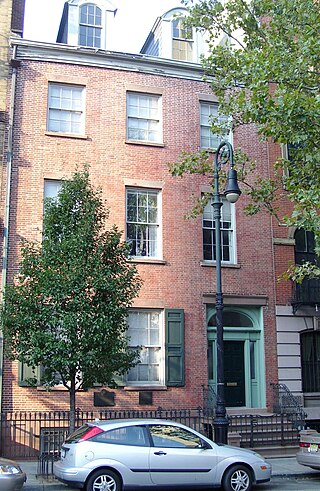
The Hamilton Fish House, also known as the Stuyvesant Fish House and Nicholas and Elizabeth Stuyvesant Fish House, is where Hamilton Fish (1808–93), later Governor and Senator of New York, was born and resided from 1808 to 1838. It is at 21 Stuyvesant Street, a diagonal street within the Manhattan street grid, between 9th and 10th Streets in the East Village neighborhood of New York City. It is owned by Cooper Union and used as a residence for the college's president.

The John Street United Methodist Church – also known as Old John Street Methodist Episcopal Church – located at 44 John Street between Nassau and William Streets in the Financial District of Manhattan, New York City was built in 1841 in the Georgian style, with the design attributed to William Hurry and/or Philip Embury. The congregation is the oldest Methodist congregation in North America, founded on October 12, 1766 as the Wesleyan Society in America.

Edgehill Church at Spuyten Duyvil is a former United Church of Christ parish church located at 2570 Independence Avenue in the Spuyten Duyvil vicinage of The Bronx, New York City. Its congregation was founded in 1869 as the mission chapel affiliated with the Riverdale Presbyterian Church, serving the workers at the nearby Johnson Iron Foundry. The church, described by the AIA Guide to New York City as a "picturesque eclectic sanctuary", was designed by architect Francis Kimball in a mixture of styles – Romanesque Revival, Tudor Revival and Shingle style – and was built from 1888–1889. It features stained glass windows designed by Louis Comfort Tiffany.
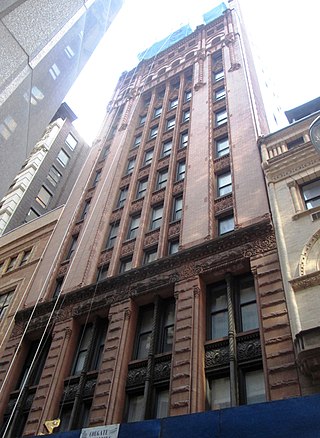
56 Pine Street – originally known as the Wallace Building after its developer, James Wallace – at 56-58 Pine Street between Pearl and William Streets in the Financial District of Manhattan, New York City, was built in 1893-94 and was designed by Oscar Wirz in the Romanesque Revival style.

The Metropolitan Baptist Church, located at 151 West 128th Street on the corner of Adam Clayton Powell Jr. Boulevard in the Harlem neighborhood of Manhattan, New York City, was originally built in two sections for the New York Presbyterian Church, which moved to the new building from 167 West 111th Street. The chapel and lecture room were built in 1884-85 and were designed by John Rochester Thomas, while the main sanctuary was constructed in 1889-90 and was designed by Richard R. Davis, perhaps following Thomas's unused design. A planned corner tower was never built.

The Flatbush Reformed Protestant Dutch Church, also known as the Flatbush Reformed Church, is a historic Dutch Reformed church – now a member of the Reformed Church in America – at 890 Flatbush Avenue in the Flatbush neighborhood of Brooklyn, New York City. The church complex consists of the church, cemetery, parsonage and church house.
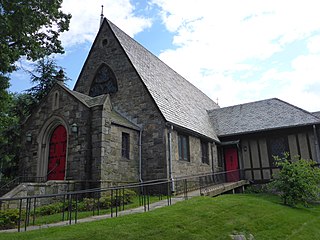
Riverdale Presbyterian Church is a historic Presbyterian church located at 4761-4765 Henry Hudson Parkway in the Riverdale neighborhood of the Bronx, New York City. It was designed in 1863 by architect James Renwick Jr. The church is a fieldstone building in an English-inspired Late Gothic Revival style. It was substantially enlarged in 1936.

The Old New York Evening Post Building is the former office and printing plant of the New York Evening Post newspaper located at 20 Vesey Street between Church Street and Broadway in the Financial District of Manhattan, New York City. It was built in 1906-07 and was designed by architect Robert D. Kohn for Oswald Garrison Villard, who owned the Post at the time, and is considered to be "one of the few outstanding Art nouveau buildings" ever constructed in the United States.

The former 18th Police Precinct Station House and Stable of the Brooklyn Police Department is a historic police station and stable located in the Sunset Park neighborhood of Brooklyn, New York City. The two buildings were completed in 1892. The station house, which later was used by the New York City Police Department's 68th Precinct, is a three-story brick building with carved stone detailing in the Romanesque Revival style. It features a projecting corner tower and Norman-inspired projecting main entrance portico. The stable is a two-story brick building connected to the station house by a one-story brick passage. It ceased being used as a police station in 1970, and was bought by the Sunset Park School of Music.

The Harlem Courthouse at 170 East 121st Street on the corner of Sylvan Place – a remnant of the former Boston Post Road – in the Harlem neighborhood of Manhattan, New York City, was built in 1891-93 and was designed by Thom & Wilson in the Romanesque Revival style. The brick, brownstone, bluestone, granite and terra cotta building features gables, archways, an octagonal corner tower and a two-faced clock. It was built for the Police and District Courts, but is now used by other city agencies.
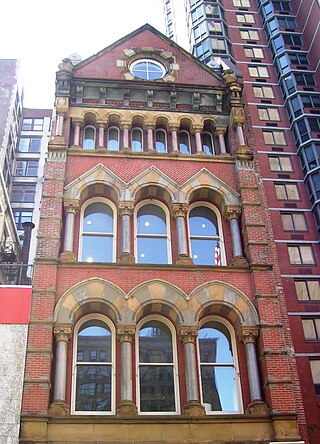
The David S. Brown Store at 8 Thomas Street between Broadway and Church Street in the TriBeCa neighborhood of Manhattan, New York City was built in 1875-76 for a soap manufacturer. It was designed by J. Morgan Slade in the Victorian Gothic style, as influenced by John Ruskin and French architectural theory. The building has been called "An elaborate confection of Romanesque, Venetian Gothic, brick, sandstone, granite, and cast-iron parts..."

The John Rankin House at 440 Clinton Street at the corner of Carroll Street in the Carroll Gardens neighborhood of Brooklyn, New York City was built in the Greek Revival style in 1840, at which time it stood by itself, surrounded by farmland and overlooking Upper New York Bay.

The Albemarle–Kenmore Terraces Historic District is a small historic district located in the Flatbush neighborhood of Brooklyn, New York City. It consists of two short cul-de-sacs, Albemarle Terrace and Kenmore Terrace, off of East 21st Street, and the 32 houses on the two streets, as well as a four-family apartment building at the end of Albemarle Terrace. The New York City Landmarks Preservation Commission, which designated the district as a landmark in 1978, noted that the "terraces are distinguished by the uniform use of materials, height and color producing a harmonious effect".

The Cobble Hill Historic District is a municipal and national historic district located in the Cobble Hill neighborhood of Brooklyn, New York City. The national district consists of 796 contributing, largely residential buildings built between the 1830s and 1920s. It includes fine examples of Greek Revival, Italianate, and Queen Anne style row houses. Also in the district are a number of notable churches, including ones by Richard Upjohn and Minard Lafever, 1851–52). A number of early 20th century apartment buildings are part of the district as well.
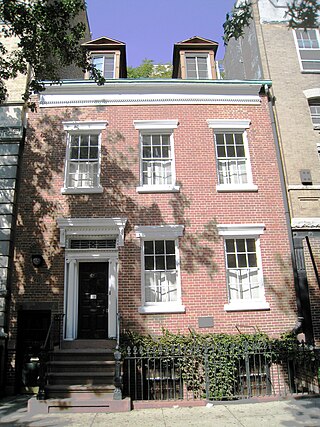
Charles Street is a street in the West Village neighborhood of Manhattan in New York City. It runs east to west from Greenwich Avenue to West Street. The street was named after Charles Christopher Amos, who owned the parcel the street passed through. Amos is also the namesake of Christopher Street, two blocks to the south, and the former Amos Street, which is now West 10th Street. Charles Lane is a one-block alley located between Charles and Perry Streets and Washington and West Streets. From 1866 to 1936, the section of Charles Street between Bleecker Street and West 4th Street was called Van Ness Place after a farm, owned by the Van Ness family, which had occupied the square bounded by Bleecker, West 4th, Charles and Perry Streets until 1865.

























